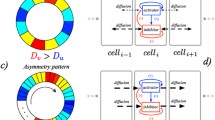Abstract
The computational complexity of diffusion-limited aggregation and fluid invasion in porous media is studied. The time requirements on an idealized parallel computer for simulating the patterns formed by these models are investigated. It is shown that these growth models are P-complete. These results provide strong evidence that such pattern formation processes are inherently sequential and cannot be simulated efficiently in parallel.
Similar content being viewed by others
References
T. Vicsek,Fractal Growth Phenomena (World Scientific, Singapore, 1989).
J. Apostolakis, P. Coddington, and E. Marinari,Europhys. Lett. 17:189 (1992); R. C. Brower, P. Tamayo, and B. York,J. Stat. Phys. 63:73 (1991).
C. H. Bennett, inComplexity, Entropy, and the Physics of Information, Wojciech H. Zurek, ed. (Addison-Wesley, 1990).
A. Gibbons and W. Rytter,Efficient Parallel Algorithms (Cambridge University Press, Cambridge, 1988).
S. A. Cook,Information Control 64:2 (1985).
R. Greenlaw, H. J. Hoover, and W. L. Ruzzo, A Compendium of Problems Complete for P, Department of Computer Science, University of New Hampshire, Technical Report TR 91-14 (1991).
M. Jerrum and A. Sinclair,SIAM J. Computing, to appear.
R. Ladner,SIGACT News 7:18 (1975).
M. R. Garey and D. S. Johnson,Computers and Intractability (Freeman, San Francisco, 1979).
F. Barahona,J. Phys. A: Math. Gen. 15:3241 (1982).
J. Machta,J. Phys. A: Math. Gen. 25:521 (1992).
D. A. Huse and C. L. Henley,Phys. Rev. Lett. 54:2708 (1985).
F. Barahona,J. Phys. A: Math. Gen. 18:L673 (1985).
S. Wolfram,Theory and Applications of Cellular Automata (World Scientific, Singapore, 1986).
D. J. A. Welsh, inDisorder in Physical Systems, G. R. Grimmett and D. J. A. Welsh, eds. (Oxford University Press, Oxford, 1990).
J.-D. Chen and D. Wilkinson,Phys. Rev. Lett. 55:1892 (1985).
D. Y. C. Chan, B. D. Hughes, L. Paterson, and C. Sirakoff,Phys. Rev. A 38:4106 (1988).
Z. Koza,J. Phys. A: Math. Gen. 24:4895 (1991).
T. A. Witten and L. M. Sander,Phys. Rev. Lett. 47:1400 (1981).
L. Goldschlager,SIGACT News 9:25 (1977).
R. Anderson and E. Mayr,Information Process. Lett. 24:121 (1987).
L. A. Levin,SIAM J. Comput. 15:285 (1986).
Y. Gurevich,J. Computer Syst. Sci. 42:346 (1991).
Author information
Authors and Affiliations
Rights and permissions
About this article
Cite this article
Machta, J. The computational complexity of pattern formation. J Stat Phys 70, 949–966 (1993). https://doi.org/10.1007/BF01053602
Received:
Revised:
Issue Date:
DOI: https://doi.org/10.1007/BF01053602




